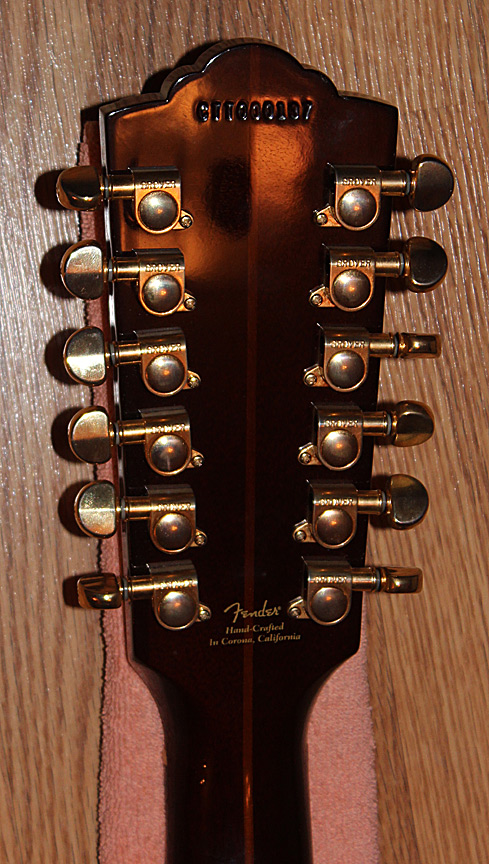Actually Fender built a dedicated assembly area (building?) for Guild because
flat-tops had never been built in Corona.
They also brought in some tooling and machinery from Westerly like the archback press, and installed a state-of the-art spray booth to be able to spray NCL in compliance with California's ever-more restrictive air quality regs.
Nope, Corona '02-'04 and Tacoma '05-'08.

HI Dougling, welcome aboard!
Fender's purchase of Guild was finalized in November of '95 while they were still at Westerly, and as Cougar suspected, they did largely practice a "hands-off" approach to the actual manufacturing process although they did take some measures to improve QC:
Several years ago member Hideglue, who worked in Westerly, mentioned "Guild's QC reached a zenith under Fender".
Some folks were a little riled buy this, thinking he meant the Fender-era guitars were better, and he had to take pains to explain that what he meant was that Fender did some things like instituting checklists to ensure no QC steps were overlooked, but not that the guitars themselves were therefore better.
In '97 Fender also opened up the Guild Nashville Custom shop which specialized in even higher-end builds than Westerly could allocate resources for, as well as special editions and custom orders. In our host GAD's Guild Catalogs page more in-depth info about the shop can be found, in the Guild Gallery magazines in the '90's section:
https://www.gad.net/Blog/guild-guitar-catalogs/.
Westerly itself was a very old building with ventilation consisting of opening the skylights. Not a great foundation to start climate-controlled manufacturing for even greater consistency in the finished product. Also, Rhode Island was starting to implement air quality regs similar to California's and that would likely have doomed Westerly's ability to spray NCL without expensive retrofitting of the building itself.
Fender decided it would be better to move Guild to Corona, most likely a more cost-effective solution than trying to "fix" Westerly. So Westerly was shut down in August of '01 although finished inventory was still being shipped as late as November, like my F65ce.
Corona's first official production year was '02, and that's when they started hitting some bumps in the road: A high rate of finish blemishes early on, and negative critical assessment of the build quality there.
Former member Jay Pilzer wrote an article about it in Vintage Guitar:
Since its beginnings in 1952, Guild has gone through many changes in ownership, location, marketing approach, and design philosophy. In the course of a change in ownership and three moves, the Guild line has seen major changes in materials, structural specifications, equipment, personnel, and...

www.vintageguitar.com
Once they got over their learning curve, the guitars were just fine. Coronas have actually aged well and many members love theirs, myself included.
But, during that time Fender acquired the Tacoma Guitar Company and decided to move Guild manufacturing to Tacoma Washington.
So Corona was shut down in summer of '04 and moved to Tacoma. Unsold inventory as well as warranty return and "B" stock was liquidated through an outfit called MIRC.
MIRC in turn undertook to ensure none of those guitars could later be submitted to Fender for warranty claim by obliterating the s/n's, and in turn sold 'em to dealers, with
no warranty, even though many of 'em may have had no actual manufacturing defects, or only finish blems.
The flood of cheap unwarranted guitars gave Guild's rep a black eye and alienated dealers struggling to sell warrantied "A" stock against 'em.
But Fender did continue investing in Guild R&D and also brought out the GAD (
Guild Acoustic Design) line of MIC guitars in spring of '04.
The fruits of the R&D investment were seen in Tacoma, '05-08. By all accounts Tacoma also signaled a return to lighter build styles.
But, during that time Fender acquired Ovation Guitars and decided to move Guild manufacturing Ovation's facility in New Hartford Connecticut. Never one to learn a lesson the first time around, Fender let good ol' MIRC handle the liquidation chores once again with results similar to the first round's from Corona.
I know 2 local dealers who dropped Guild at that point, having lost confidence in the brand itself.
In New Hartford Fender decided to implement a "low volume/high quality" business model and attempted to re-make Guild into a sort of "entry-level boutique" brand. They decided they no longer wanted it to be just another one of the dozens of brands on the wall at a Guitar Center.
This was when the complaints about the difficulty of just finding one to play started to arise. New Hartford's output was
very low, with output estimated at substantially less than 5000 units/year.
Experiencing financial woes of their own, Fender finally decided to throw in the towel in 2014 and sold Guild to Cordoba Music Group.
Cordoba built a dedicated manufacturing plant for the flat-tops in Oxnard CA and took 2 years to get it into production due to California's byzantine regulatory processes. (Spraying NCL was NOT actually ever a problem, it was one of the first approvals obtained. Electric power turned out to be a major bug-a-boo)
SO: 4 plants with low output in 13 years, with around 3 accumulated years of
no production, now you know why they're so hard to find in a brick-and mortar store.
I'd thank you for persevering but I bet the M20's reward enough..



